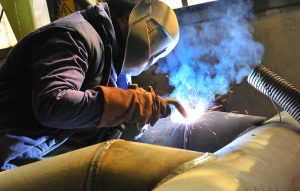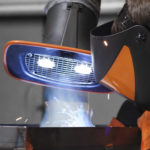Limit values for welding fumes: Let’s count the particles!
Are today’s limit values for welding fumes still relevant in their current form? Science and the industrial sector have doubts. KEMPER GmbH argues in favour of measuring the number of particles when evaluating welding fumes concentration. The true health hazard for employees is before the limit is reached – an essay by Björn Kemper.
The last time Occupational Exposure Limits (OEL) caused a stir in the metalworking sector was when the permissible maximum value for respirable dust was lowered by more than 60 % to 1.25 mg/m³ in Germany. This was in 2014. The legislators adjusted the general dust limit value to new occupational medicine findings. The transition period for adherence to this limit value applies  until the end of 2018. In addition, a general limit value is in place for the E-Group (so-called respirable dusts) of more than 10 mg/m³ (for definitions check here). Furthermore, there are various other specific limit values for different substances. A minimization requirement applies to carcinogenic substances.
until the end of 2018. In addition, a general limit value is in place for the E-Group (so-called respirable dusts) of more than 10 mg/m³ (for definitions check here). Furthermore, there are various other specific limit values for different substances. A minimization requirement applies to carcinogenic substances.
Germany is not the only country to determine limit values for a welding fume maximum value. The Netherlands are e.g. even more restrictive than Germany – with a limit value for respirable dusts of 1 mg/m³. Whilst in the US, the maximum value is 5 mg/m³. There is one thing that connects these three countries: Wherever the legislator governs the situation with regulations, the values are determined by weight. Is this still relevant? In the current form, we have to clearly say NO.
Current limits for welding fumes distort actual hazards
These limit values, even if lowering the limit value for A-dust in Germany was based on occupational medicine findings, provide a false impression and distract from the actual dangers of welding fumes. Weight-based limit values for the exposure of a welder to hazardous particles says the following: Stick to the limit values, keep within the law. Yet, on the other hand, everybody assumes that the danger has passed. And that is simply not the case.
The actual dangers are below these limit values. For example: If there are a few large dust particles, then the limit value will be exceeded very quickly. In contrast, millions of the smallest fine dust particles in the nano range, which we cannot even perceive with our eyes, can be below the limit value due to their low weight. The weight limit value does not even capture these hazards. Many welders currently have no idea about these hazards.
Ultra-fine particles of welding fumes cause sickness
It is above all the ultra-fine and extremely light fine dust particles which make production employees ill. Current studies [for example: World Health Organisation (2016): Ambient air pollution: A global assessment of exposure and burden of disease / Max-Planck-Institute for Chemistry (2015): The contribution of outdoor air pollution sources to premature mortality on a global scale] confirms that fine dust is a cause of an increase in heart attack risk, promotes dementia, causes cancer and may even lead to death. The World Health Organization even classes fine dust as a direct cause of lung cancer.
 What conclusions have we come to with regards to workplace limit values? We have to count the particles! The relevant technology, which count particles right down to the nano range, is already available. Even professional association test instruments for BG-checks determine the number of particles in the breathing zone of a welder first before weighing them. So why not use the available data basis further?! The greatest challenge is in the specification of such limit values. In future, there may be a relevant maximum value for different dust classes (E-dust and A-dust); for example specified in the number of particles in the dust class per square meter per time. The occupational medicine findings are also available and have to be used for such new calculations.
What conclusions have we come to with regards to workplace limit values? We have to count the particles! The relevant technology, which count particles right down to the nano range, is already available. Even professional association test instruments for BG-checks determine the number of particles in the breathing zone of a welder first before weighing them. So why not use the available data basis further?! The greatest challenge is in the specification of such limit values. In future, there may be a relevant maximum value for different dust classes (E-dust and A-dust); for example specified in the number of particles in the dust class per square meter per time. The occupational medicine findings are also available and have to be used for such new calculations.
Today’s welding fumes extraction also very efficient in ultra-fine range
This point of view gains additional relevance, also when considering the alleged technical progress in welding. Manufacturers advertise today with seemingly low-emission welding processes. And yes, that is correct: In the visible range, the welding fumes quantity decreases from a subjective point of view. This means that heavy particles disappear and therefore the limit value is much more effectively observed. What the welder can no longer see: The number of fine dust particles increases in the invisible range and therefore the health of the employee is put at risk. After all: It is mainly the small particles that cause damage in the human body.
One thing is certain amongst all hazards: The welding fumes filters are already so efficient today that they themselves can filter a huge amount of the ultra-fine particles from the contaminated air. Particles for which there are not even any evaluations yet.





